Resident Crews of the International Space Station (ISS)
![]()
ISS: Expedition 23 |
 |
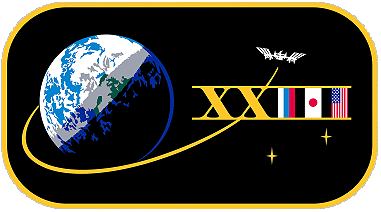 |
 |
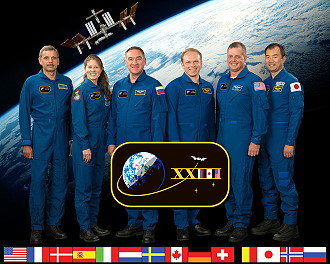 |
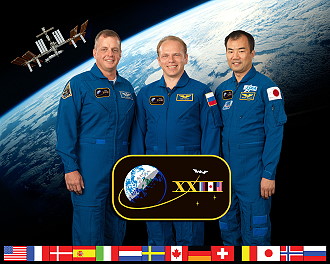 |
alternative crew photo |
alternative crew photo |
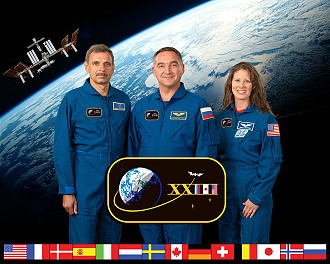 |
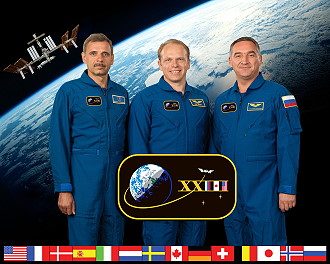 |
alternative crew photo |
|
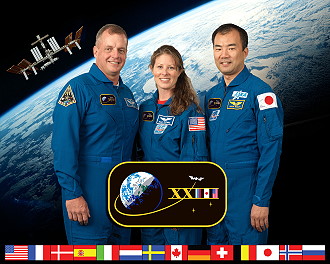 |
|
![]()
Crew, launch- and landing data
| No. | Nation | Surname | Given names | Position | Spacecraft (launch) |
Launch date |
Launch time |
Spacecraft (landing) |
Landing date |
Landing time |
Mission duration |
Orbits |
| 1 | Kotov | Oleg Valeriyevich | ISS-CDR | Soyuz TMA-17 | 20.12.2009 | 21:52:00.061 UTC | Soyuz TMA-17 | 02.06.2010 | 03:24:32.2 UTC | 163d 05h 32m 32s | 2574 | |
| 2 | Skvortsov | Aleksandr Aleksandrovich Jr. | Flight Engineer-1 | Soyuz TMA-18 | 02.04.2010 | 04:04:33.061 UTC | Soyuz TMA-18 | 25.09.2010 | 05:23:10.8 UTC | 176d 01h 18m 38s | 2756 | |
| 3 | Caldwell-Dyson | Tracy Ellen | Flight Engineer-2 | Soyuz TMA-18 | 02.04.2010 | 04:04:33.061 UTC | Soyuz TMA-18 | 25.09.2010 | 05:23:10.8 UTC | 176d 01h 18m 38s | 2756 | |
| 4 | Korniyenko | Mikhail Borisovich | Flight Engineer-3 | Soyuz TMA-18 | 02.04.2010 | 04:04:33.061 UTC | Soyuz TMA-18 | 25.09.2010 | 05:23:10.8 UTC | 176d 01h 18m 38s | 2756 | |
| 5 | Noguchi | Soichi | Flight Engineer-5 | Soyuz TMA-17 | 20.12.2009 | 21:52:00.061 UTC | Soyuz TMA-17 | 02.06.2010 | 03:24:32.2 UTC | 163d 05h 32m 32s | 2574 | |
| 6 | Creamer | Timothy John "TJ" | Flight Engineer-6 | Soyuz TMA-17 | 20.12.2009 | 21:52:00.061 UTC | Soyuz TMA-17 | 02.06.2010 | 03:24:32.2 UTC | 163d 05h 32m 32s | 2574 |
unofficial Backup Crew
| No. | Nation | Surname | Given names | Position |
| 1 | Shkaplerov | Anton Nikolayevich | ISS-CDR | |
| 2 | Samokutyayev | Aleksandr Mikhailovich | Flight Engineer | |
| 3 | Kelly | Scott Joseph | Flight Engineer | |
| 4 | Borisenko | Andrei Ivanovich | Flight Engineer | |
| 5 | Furukawa | Satoshi | Flight Engineer | |
| 6 | Wheelock | Douglas Harry | Flight Engineer |
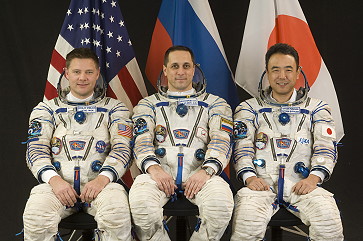 |
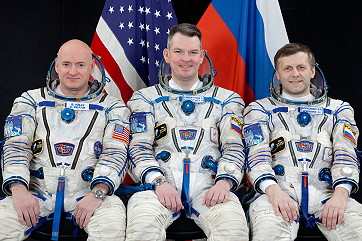 |
|
Source: Roscosmos PAO |
 |
Expedition Report
|
Launch from the Baikonur Cosmodrome (Aleksandr
Skvortsov, Mikhail
Korniyenko and Tracy
Caldwell-Dyson with
Soyuz
TMA-18). Oleg
Kotov,
Soichi
Noguchi and Timothy
Creamer were onboard since December 22, 2009 (arrival with
Soyuz
TMA-17). ISS Expedition 23 began with the undocking of spacecraft Soyuz TMA-16 on March 18, 2010 at 08:03:03 UTC. The former Expedition 22 (Jeffrey Williams and Maksim Surayev) returned safely to Earth. With the arrival of Soyuz TMA-18 on April 04, 2010 at 05:24:50 UTC the Expedition 23 became a six-person-crew. Soyuz TMA-18 carried Aleksandr Skvortsov, Mikhail Korniyenko and Tracy Caldwell-Dyson to the space station. On April 07, 2010 Space Shuttle STS-131 docked with the International Space Station. The primary payload of STS-131 (ISS-MPLM Leonardo) was a Multi-Purpose Logistics Module loaded with supplies and equipment for the International Space Station. The mission also removed and replaced an ammonia tank assembly outside the station on the S1 truss. STS-131 furthermore carried several on-board payloads; this mission had the most payloads since STS-107. The MPLM also carried the third and final Minus Eighty Degree Laboratory Freezer for ISS (MELFI), Window Orbital Research Facility (WORF), one Crew Quarters Rack, the Muscle Atrophy Resistive Exercise (MARES) rack, Resupply Stowage Racks (RSRs), as well as Resupply Stowage Platforms (RSPs). As the last round-trip for the Leonardo Multi-Purpose Logistics Module, Discovery's mission provided the International Space Station with not only some 8 tons of science equipment and cargo, but also one last opportunity to send a large load of cargo back to the ground. Leonardo served as basically a moving van for the space station, allowing the shuttle to, first of all, deliver shipments of equipment and supplies larger than any other vehicle could accommodate, and, second, to return science experiments, unneeded hardware and trash to the ground - all other cargo transfer vehicles burn up in the Earth's atmosphere. And although Leonardo returned to the station once more on the last space shuttle mission later in 2010, this was scheduled to be its last round trip - Leonardo remained permanently at the station after STS-133. So, while it delivered one more batch of goods, the cargo returning on STS-131 was the last that it brought home. The Lightweight Multi-Purpose Equipment Support Structure Carrier (LMC) carried a refurbished Ammonia Tank Assembly (ATA) to the ISS. The refurbished ATA was removed from the Space Station and returned for use on this mission during STS-128. It was swapped with an empty tank which will ride home on the LMC. This mission was the second flight of the TriDAR, a 3D dual-sensing laser camera, intended for potential use as an autonomous rendezvous and docking sensor. TriDAR provides guidance information that can be used to guide a vehicle during rendezvous and docking operations in space. TriDAR does not rely on any reference markers, such as reflectors, positioned on the target spacecraft. To achieve this, it relies on a laser-based 3D sensor and a thermal imager. Geometric information contained in successive 3D images is matched against the known shape of the target object to calculate its position and orientation in real-time. The TriDAR tracked the ISS position and orientation from the shuttle during docking, undocking, and flyaround operations. Once Discovery docked to the International Space Station (ISS), a series of leak checks were done on both sides of the hatch by the shuttle and station crews STS-131/Expedition 23. The hatches between the two vehicles were opened at 09:11 UTC (05:11 EDT), which was 30 minutes earlier than planned. Once the hatches were opened the STS-131 crew got a safety briefing from the station crew, then began to transfer items that would be needed for later in the day and early on flight day 4. Two items that were transferred were the two EMUs that will be used for the three spacewalks. The crew also completed a grapple of the Orbiter Boom Sensor System (OBSS) with the Space Station Remote Manipulator System (SSRMS) also known as Canadarm2. Once the OBSS was grappled it was unberthed from the starboard sill of the space shuttle payload bay, and handed off to the SRMS. Throughout the day, after docking to the station, the shuttle crew began downlinking all of the inspection video from flight day 2, and launch imagery and video. On April 08, 2010 Stephanie Wilson and Naoko Yamazaki grappled and berthed the Multi-purpose Logistics Module (MPLM) Leonardo. The MPLM was berthed to the station at 04:24 UTC (00:24 EDT). The hatches were opened by station Flight Engineer Soichi Noguchi and shuttle mission specialist Clayton Anderson at 11:58 UTC (07:58 EDT). The joint STS-131/Expedition 23 crews began transferring cargo from the MPLM, with the first item being a Rate Gyro Assembly (RGA) which will be replaced on the first spacewalk of the mission. The Italian built module's more than 17,000 pounds (7,711 kg) of cargo included four experiment racks along with the final private crew quarters. This is the final roundtrip to the station for the 21-foot-long (6.4 meters), 15-foot-diameter (4.6 meters) Leonardo. Once back on Earth, the module will be reconfigured with increased shielding on the outside for the STS-133 mission in September 2010 when it will be left on the station as a permanent module. The first EVA by Richard Mastracchio and Clayton Anderson occurred on April 09, 2010 (6h 27m). The crew inside used the station's robotic arm to remove a new ammonia tank from shuttle's payload bay and temporarily stow it on the station. Ammonia is used to move excess heat from inside the station to the radiators located outside. The spacewalkers then retrieved a seed experiment outside the Japanese laboratory. Next, the pair installed a grapple bar to the new ammonia tank on the station's truss. The pair also replaced a failed gyroscope that is part of the station's navigation system. They also accomplished several "get-ahead" tasks, removing 11 out of 12 p-clamps slated for a future spacewalk. The first leg of the ammonia tank assembly swap started in the shuttle's cargo bay. After picking up a handle that the space station robotic arm used to grasp the new tank, Richard Mastracchio moved to the cargo bay and installed it on the new tank then began releasing the four bolts that held it in place during its journey to the station. Clayton Anderson, meanwhile, moved to the station's starboard truss segment and disconnected the old tank's four ammonia and nitrogen lines before meeting Richard Mastracchio in the cargo bay to do the same on the new tank. Once the lines were disconnected and the bolts released, Clayton Anderson and Richard Mastracchio worked together to lift it out of the cargo bay and into position for the robotic arm to grasp it and fly it to the external stowage platform 2 on the Quest airlock. While it made its way there, Clayton Anderson cleaned up their work area while Richard Mastracchio moved to the Kibo laboratory's porch - the Japanese Experiment Module's exposed facility - to retrieve the Micro-Particles Capture/Space Environment Exposure Device experiment and temporarily stowed it outside of the airlock - he moved it inside later in the spacewalk. They met the robotic arm back at the external stowage platform to install another handle on the new ammonia tank assembly, while it was still in the grasp of the arm. This second handle was used to attach the assembly to a temporary storage location on the robotic arm's mobile transporter, where it waited for installation on the second spacewalk of the mission. Once that handle was installed, the robotic arm flew the tank assembly to the storage location, and the spacewalkers moved on to other tasks. The first of the tasks was the replacement of a rate gyro assembly on the center section of the station's truss. While moving the experiment inside of the airlock, Richard Mastracchio retrieved a new rate gyro assembly, then moved to the center of the truss, where Clayton Anderson had removed from inside the truss, two of the four bolts holding the old assembly in place. When Richard Mastracchio arrived at the truss segment, he opened insulation protecting the assembly, disconnected two power cables and released the final two bolts. He then removed the old assembly and slided the new one into place, engaging the first two bolts, connecting the power cables and then engaging the last two bolts. Meanwhile, Clayton Anderson had moved on to their final tasks of the mission: The preparation of the batteries on the farthest port solar array for replacement on a later mission. There are two sets of batteries, and the first set was replaced on STS-127, and some of the equipment used in that work - a gap spanner and a foot restraint - was still in place. Clayton Anderson moved it from the set of batteries replaced during STS-127 to the set of batteries he and Richard Mastracchio were working with. The spacewalker was loosening the 12 bolts holding the six batteries in place before heading back inside the station. Flight day 6 was dedicated to transferring supplies from the MPLM Leonardo and the space shuttle mid-deck. The crews transferred the Windows Observational Research Facility (WORF) to the Destiny lab. Mission specialist Naoko Yamazaki, along with Flight Engineer Soichi Noguchi also transferred the Express Rack 7 (ER7) to its final location. During the crews morning, a smoke alarm sounded in the Russian segment of the station, which prompted the joint crew to move into emergency procedures. However, the alarm was false and was cleared within a couple of minutes and all normal work resumed. Meanwhile mission managers extended the flight by one day to enable a standard late inspection of the shuttle heat shield to occur while the shuttle is docked to the International Space Station. The second EVA was performed by Richard Mastracchio and Clayton Anderson on April 11, 2010 (7h 26m). Using the station's arm, the astronauts removed the empty ammonia tank from the station's truss and temporarily stowed it on an equipment cart. The new tank then was installed and connected to the truss for use. Richard Mastracchio and Clayton Anderson began the second spacewalk at the site of the spent ammonia tank assembly on the first segment of the station's starboard truss. Clayton Anderson disconnected two electrical cables. Then he and Richard Mastracchio worked together to release the four bolts holding the assembly in place, lifted it off of the station's truss and handed it to the robotic arm. Richard Mastracchio then moved a crew and equipment translation aid cart - or CETA cart - into place to provide temporary storage for the old ammonia tank assembly. When the assembly arrived via robotic arm at the CETA cart via robotic arm, the spacewalkers tied it to the cart with six tethers. That freed the robotic arm up for the installation of the new ammonia tank assembly. While it was retrieving the new assembly from the mobile transporter system, Richard Mastracchio and Clayton Anderson took advantage of the time by installing two radiator grapple fixture stowage beams on the first port segment of the station's truss. These beams were used temporarily to store handles that would be necessary if a radiator ever needed to be replaced. By the time they were done with that, the new ammonia tank assembly should be in place. Richard Mastracchio first removed the handle that allowed it to be stored on the mobile transporter. Then he and Clayton Anderson worked together to install it, engaging four bolts and connecting six cables. Clayton Anderson and Richard Mastracchio ran into a small problem when one of the four bolts that holds the tank in place wouldn't turn. They loosened the other three and tried them all again and the fourth bolt was successfully tightened. The two spacewalkers helped guide the SSRMS to temporarily stow the old ATA on the truss structure. The new ATA had its electrical connections made, but the fluid connections were deferred until the third spacewalk since the EVA was behind the time-line. The third and final EVA was conducted by Richard Mastracchio and Clayton Anderson on April 13, 2010 (6h 24m). First, they finished the complicated change out of the large ammonia tank assembly. Using the station's arm, the crew moved the old tank into the shuttle's payload bay for return to Earth. The spacewalkers also removed the grapple bar from the old ammonia tank and stowed it on a spare parts platform. Finally, Richard Mastracchio and Clayton Anderson retrieved debris shields from the Quest airlock to return to Earth. Due of the delays, the planned installing a plate and camera light on the Dextre robot, the removal of thermal covers on Dextre and replacement of a burned-out light on a truss camera were not carried out. Meanwhile, engineers on the ground started to troubleshoot a stuck valve in a nitrogen tank assembly that's needed to pressurize a new ammonia tank installed on the space station by Discovery's astronauts. The ammonia tank was installed during three spacewalks by Mission Specialists Richard Mastracchio and Clayton Anderson. Following some discussions the flight controllers have decided not to add a possible fourth spacewalk plus an additional one-day mission extension to the shuttle Discovery's mission to replace a nitrogen tank in the International Space Station's ammonia coolant system, concluding the system can safely operate for an extended period despite a stuck valve preventing normal pressurization. On April 15, 2010 Stephanie Wilson and Naoko Yamazaki using the space station's robotic arm packed the Leonardo Multipurpose Logistics Module back into Discovery's cargo bay for return home. The Leonardo cargo module was detached from the International Space Station late after a lengthy delay. It was parked overnight in a "low hover" position just above the shuttle's payload bay and the astronauts completed the installation next day morning. The operation to move the Leonardo Multi-Purpose Logistics Module (MPLM) from the International Space Station back to space shuttle Discovery's cargo bay for return to Earth has been delayed due to a problem with the mechanism that holds the MPLM in place. Next Stephanie Wilson, Dorothy Metcalf-Lindenburger and Discovery Pilot James Dutton teamed up to begin the late inspection of the shuttle's thermal protection system. Working in shifts with some help from Commander Alan Poindexter and Naoko Yamazaki, they used Discovery's robotic arm and the orbiter boom sensor system to look at reinforced carbon-carbon of the wing leading edges and the nose cone, as well as and the heat-resistant tiles. The inspection, scheduled for about seven hours, was finished almost three hours ahead of schedule. It was done while the shuttle was still docked so the images could be sent down by the station's high-data-rate system. Discovery's high-data-rate Ku band antenna was not working. On April 17, 2010 STS-131 undocked from the ISS and moved to a distance of about 450 feet (137.2 meters), where James Dutton began to fly around the station. James Dutton circled the shuttle around the station at a distance of 600 - 700 feet (182-213 meters). Once the shuttle completed 1.5 revolutions of the complex, James Dutton fired Discovery's jets to leave the area. The shuttle began to increase its distance behind the station with each trip around the earth while ground teams analyzed data from the late inspection of the shuttle's heat shield. However, the distance was close enough to allow the shuttle to return to the station in the unlikely event that the heat shield is damaged, preventing the shuttle's safe re-entry. The launch of Progress M-05M occurred at 17:15 UTC on April 28, 2010. Following three days of free flight, Progress M-05M docked with the Pirs module of the ISS at 18:30 UTC on May 01, 2010. During rendezvous operations, when Progress M-05M was about a kilometer from the station, its Kurs docking system failed. Cosmonaut Oleg Kotov used the backup TORU system to manually control the rendezvous and docking, setting a record for the furthest distance a Progress spacecraft was flown under manual control. The Progress M-03M spacecraft, which had previously been occupying the Pirs docking port, departed on April 22, 2010 to make way for Progress M-05M. Progress M-05M remained docked with the space station until October 25, 2010. The spacecraft undocked from the Pirs docking compartment at 14:25 UTC on October 25, 2010. Expedition 25 Flight Engineer Fyodor Yurchikhin closed and performed leak checks on the hatch between the space station and Progress M-05M on October 22, 2010, completing preparations for the spacecraft's undocking. The undocking of Progress M-05M cleared the way for the launch of the Progress M-08M spacecraft on October 27, 2010 from the Baikonur Cosmodrome. On October 30, 2010, Progress M-08M docked to the Pirs docking compartment vacated by Progress M-05M. After undocking the spacecraft was transferred to a lower orbit. The Progress M-05M spacecraft spent three weeks orbiting a safe distance from the space station. The autonomous mission enabled Russian scientists to conduct geophysical experiments before spacecraft's demise. On November 15, 2010 Progress M-05M was deorbited and drowned in the South Pacific Ocean several thousand kilometers east of New Zealand. Progress engines were activated by the on-board computer and retroburn was initiated at 8:50 UTC. The main engine operated for 186.2 seconds, providing the braking burn of 89.7 mps to the spacecraft. The remaining parts of the Progress M-05M, not burnt during the reentry fell down in the area of 47°57'S 220°44'W at about 09:35 UTC. On May 12, 2010 the International Space Station residents moved the Soyuz TMA-17 capsule from one docking port to another, freeing up the spot where space shuttle Atlantis' astronauts (STS-132) installed the new Rassvet module. The next Space Shuttle docking with the International Space Station was STS-132 on May 16, 2010. STS-132 (ISS ULF-4 ICC, MRM-1 (now Rassvet), ERA) carried the Russian Rassvet Mini-Research Module 1 to the International Space Station. Rassvet means "dawn" in Russian. The module was built by Russian aerospace company Energia. The Mini-Research Module-1 (MRM-1) is a new Russian module that will be delivered to the International Space Station by space shuttle Atlantis on the STS-132 mission. MRM-1, which has been named Rassvet, a Russian word meaning dawn, will be used primarily for cargo storage and some payload operations. The module will be berthed to the Earth-facing port of the Zarya module using the station robotic arm on Flight Day 5. MRM-1 is 19.7 feet long (6 meters), has a maximum exterior diameter of 7.7 feet (2.35 meters) and weighs 11,188 pounds (5,075 kilograms). For its flight to the station, the MRM-1 will carry a total of 6,482 pounds (2,940 kilograms) of cargo on its internal and exterior stowage locations while in Atlantis' payload bay. On its shell, Rassvet will carry a spare elbow joint for the European Robotic Arm (ERA) and outfitting equipment for the Russian Multi-Purpose Laboratory Module (MLM), which is scheduled to launch on a Russian rocket in 2012. The outfitting equipment will include a radiator, an airlock for payloads, and a Portable Work Post (PWP) that will provide a spacewalk worksite for ERA activation, checkout, and operations. Once MRM-1 is installed on its Zarya port, its 614 cubic feet (17 cubic meters) of pressurized volume, will increase the space station's total pressurized volume to 29,561 cubic feet (837 cubic meters), and its 207 cubic feet (5.8 cubic meters) will increase the total habitable volume to 12,705 cubic feet (360 cubic meters). After installation and Atlantis' departure, the station's total mass will be 815,519 pounds (369,914 kilograms). Also on board Atlantis was the Integrated Cargo Carrier-Vertical Light Deployable (ICC-VLD2) pallet, holding a Ku-band Space to Ground Antenna (SGANT), the SGANT boom assembly, an Enhanced Orbital replacement Unit (ORU) Temporary Platform (EOTP) for the Canadian Dextre robotic arm extension, Video and Power Grapple fixtures (PVGF) and six new battery ORUs. The six new batteries replaced older ones on the P6 truss of the ISS. The old batteries were placed on the ICC-VLD pallet for return to Earth. Astronauts use the Integrated Cargo Carrier (ICC) to help transfer unpressurized cargo such as Orbital Replacement Units (ORUs) from the space shuttle to the International Space Station and from the station to worksites on the truss assemblies. The carrier also is used to return items for refurbishment. The Astrium ICC, formerly provided by SPACEHAB Inc., is an unpressurized flatbed pallet and keel yoke assembly housed in the shuttle's payload bay. Constructed of aluminum, it is approximately 8 feet long (105 inches = 2.4 meters), 13 feet wide (165 inches = 4.0 meters) and 10 inches (25.4 centimeters) thick, and carries cargo on both the top and bottom faces of the pallet. Using modular elements, several pallet configurations are available, accommodating various mass capabilities and cargo envelopes. The ICC configuration flown on STS-132 is called the ICC - VLD and provides heater power and electrical connections for the ORUs. The empty weight of the ICC - VLD is 2,645 pounds (1,200 kg). The total weight of the ORUs and ICC - VLD is approximately 8,330 pounds (3,778 kg). The STS-132 assembly mission ICC - VLD will carry replacement components and spare parts for the space station. The ICC - VLD will carry six battery ORUs for the Port 6 (P6) Integrated Equipment Assembly (IEA). The P6 containing the initial station high-power components were launched on November 30, 2000. The IEA contains 12 Battery Subassembly ORUs (six batteries) that are charged from the solar arrays during sunlit periods and provide station power during eclipse and maintenance periods. Previously, six of the original P6 battery ORUs were changed out during the STS-127 (2J/A) mission. Thirty-eight Individual Pressure Vessel (IPV) Nickel Hydrogen (Ni-H2) battery cells are connected in series and packaged in a battery ORU. Two ORUs are connected in series, utilizing a total of 76 cells to form one battery. Each battery is designed to deliver more than 25 amps in a low-demand orbit to as high as 75 amps to meet short peaking load requirements at a battery operating voltage range of 76 to 123 V dc. The batteries will be replaced during two spacewalks and the old ones will be returned. The six batteries weigh 2,204 pounds (1,000 kg) and have a design life of approximately six and a half years. In addition to the batteries, the ICC - VLD will have one Space-to-Ground Antenna (SGANT), one SGANT boom, and one Enhanced Orbital Replacement Unit Temporary Platform (EOTP). These components will be stored on External Stowage Platform 3 (ESP-3) on the Port 3 truss. When the ICC - VLD with the old batteries is returned to Earth aboard the space shuttle, it will weigh 6,017 pounds (2,729 kg). The SGANT provides Ku band communication between the space station and the Tracking Data and Relay (TDRS) satellites for payload data, video to the ground and the crew Orbiter Communications Adapter (OCA). The OCA allows for telephone calls, emails and other two-way communications services. The SGANT currently is mounted on top of the Zenith one (Z1) truss. Eventually, a second Z1 boom will be mounted with an additional SGANT in a standby backup mode. If ever needed, it could be brought on line quickly. The SGANT dish measures 6 feet (72 inches = 1.8 meters) in diameter, and 6 feet (72 inches = 1.8 meters) high, including gimbals, and weighs 194 pounds (88 kg). The SGANT Orbital Replacement Unit (ORU), the SGANT Flight Support Equipment (FSE) Installation Kit, and the Small Adapter Plate Assembly (SAPA) comprise the Integrated Assembly, SGANT FSE Installation Kit (hereafter referred to as the Integrated Assembly). The installation kit is composed of hardware that provides a mechanical, structural and electrical bonding interface between the SGANT ORU and the SAPA. The SGANT FSE Installation Kit provides thermal conditioning of the SGANT ORU. The hardware is extravehicular activity (EVA) compatible. The FSE Installation Kit is used to support transportation of SGANT ORUs from Earth to orbit, cargo transfer to the in-orbit position on the International Space Station, and return from orbit to Earth. When used with the proper carrier or storage platform, the SGANT FSE Installation Kit can be used to support storage of the SGANT ORU at in-orbit station external payload sites. It can be separated from the Passive Flight Releasable Attachment Mechanism (PFRAM) Interface Plate (IP) Assembly mounted to the launch carrier, or the station stowage platform. The SGANT Boom Assembly provides power, data, and structural support to the redundant SGANT and the Space-to-Ground Transmit Receive Controller (SGTRC) units. The SGANT Boom Assembly will attach to the Integrated Truss Structure (ITS) Z1 berthing face at the original SGANT launch location for transmission of mechanical loads and vibrations. It will position and align the redundant SGANT to be ready for use should the primary SGANT fail in orbit. The Boom Attached Cables (BAC) provide an electrical interface to the SGANT and SGTRC units for power, 1553 command and control data, and Radio Frequency (RF) signals and Intermediate Frequency (IF) signals carrying International Space Station space-to-ground communications. The waveguide is also attached to the Boom Assembly and provides a conduit for Radio Frequency (RF) signals between the SGTRC and SGANT. The Enhanced ORU Temporary Platform (EOTP) is hardware supporting the operation of the Special Purpose Dexterous Manipulator (SPDM). It is built by MDA and provided as NASA Government Furnished Equipment. Return of the EOTP is not planned for this mission. The EOTP has a Passive FRAM interface, which is used to transfer launch loads. The interface structure between EOTP and the ICC-VLD is Flight Support Equipment (FSE) developed and owned by Astrium-ST. It interfaces with the PFRAM of the EOTP. The EOTP does not require power or data interfaces while on the ICC. Atlantis docked with the ISS Pressurized Mating Adapter-2 on May 16, 2010 at 14:28 UTC as the two orbited 220 miles (350 km) over the South Pacific Ocean. After docking, the ISS was reoriented by the small vernier thrusters on Atlantis to minimize the risk of Micro-Meteoroid Orbital Debris (MMOD) impacts upon the shuttle. A series of leak checks were done on both sides of the hatch by the shuttle and station crews, before the hatches were opened at 16:18 UTC. After a brief welcoming ceremony by the station crew of Expedition 23, Atlantis' astronauts received the standard station safety briefing. The crew then got to work with initial transfers of equipment and supplies. Spacesuits were among the first items to go to the ISS. Station crew member Soichi Noguchi also transferred high-priority JAXA experiments to the Kibo module. Piers Sellers and Expedition 23 astronaut Tracy Caldwell-Dyson got to work on their joint task to relocate the ICC-VLD cargo pallet. The duo used the station's robotic arm to transfer the pallet from Atlantis to the station's mobile base system to prepare for the spacewalks. The first EVA by Garrett Reisman and Stephen Bowen occurred on May 17, 2010 (7h 25m) to install a spare space-to-ground Ku-band antenna on the station's truss, or backbone. Then they installed a new tool platform on Dextre. Once they made their way out of the Quest airlock, Garrett Reisman and Stephen Bowen moved to a pallet of equipment brought up inside the shuttle's cargo bay and moved to the robotic arm's mobile base during flight day 3. On it are six new batteries for the P6 solar array, a spare space-to-ground antenna and a new piece of equipment for the Special Purpose Dexterous Manipulator, or Dextre. At the pallet, Stephen Bowen prepared the space-to-ground antenna dish for removal, then he and Garrett Reisman each released four of the eight bolts holding the boom of the antenna onto the pallet. Garrett Reisman then climbed onto the end of the space station's robotic arm, so that he could carry the boom via the robotic arm to the Z1 segment of the station's truss system. And once Garrett Reisman was on his way, Stephen Bowen prepared for removal a new storage platform brought up for Dextre. When the spacewalkers met back up at the Z1 segment of the truss, Stephen Bowen installed the antenna boom by driving two mounting bolts, and then began connecting six power and data cables to the antenna while Garrett Reisman rode the robotic arm back to the pallet to retrieve the antenna dish, a task that required removing two more bolts. Installing the antenna dish required the spacewalkers to secure four bolts, then Garrett Reisman connected two final cables, and Stephen Bowen installed a heat shield on the antenna's group interface tube and remove locks that prevent the antenna dish from rotating. Garrett Reisman then travelled back to the spare parts pallet to pick up Dextre's new storage platform, after removing the four bolts holding it in place. He met Stephen Bowen back at Dextre on top of the Destiny laboratory, where they installed four bolts to secure the platform to the robot and connected two electrical fuses and installed a maintenance tether. While Garrett Reisman was getting off the robotic arm, Stephen Bowen wrapped up the planned work for the spacewalk by moving out to the end of the port side of the station's truss to the batteries of the P6 solar arrays, which were swapped out over the course of the following two spacewalks. He got the six batteries ready for removal by loosening the two bolts holding each one in place, and then made his way back to the airlock. During the spacewalk, several problems were encountered, the first of which was during installation of the SGANT. A slight gap was observed between the antenna dish and its mounting pole. The spacewalkers loosened the bolts and used a higher torque setting, which managed to close the gap to a smaller width. The launch locks were left on the SGANT to allow engineers on the ground to determine if the gap was acceptable, or if more troubleshooting would be needed. The second problem occurred during the installation of the SGANT, and was related to the Command and Control (CNC) computers. During installation, when Stephen Bowen removed a cover from a connector, the prime CNC computer detected an error and shutdown. The cap was a special cap which allowed the circuit for that connector to be closed, so when it was opened the sensor detected an error. The shut down of the CNC caused a 2-minute loss of communications. The safeing of the computer also stopped the Canadarm2 for a reconfiguration of the cameras being used during the spacewalk by both the robotic arm operators and observers on the ground. On May 18, 2010, the crew focused on the addition of the MRM-1 module to the space station. Commander Kenneth Ham and pilot Anthony Antonelli maneuvered Atlantis' robotic arm to unberth MRM-1 from the shuttle's payload bay at 09:49 UTC, and handed it off to the station's Canadarm2 at 10:14 UTC. Mission Specialists Garrett Reisman and Piers Sellers, working from inside the station's Cupola, then maneuvered the Canadarm2 arm to deliver MRM-1 to its new position, the Earth-facing port of the Zarya service module. The docking occurred at 12:20 UTC when the shuttle-station stack was flying above Argentina. Following the successful docking, Piers Sellers reported to Mission Control that, during the docking, he did not see the expected "capture 1" confirmation signal appear on his laptop, to which CAPCOM Stephen Swanson replied "And station, that error's expected. The reason you didn't get 'contact 1' is because Garrett (Reisman) did too good of a job flying. He went right down the middle and got a hole in one. Expedition 23 Commander Oleg Kotov also monitored the activities from the Russian segment, as the MRM-1 began its automated docking sequence for the final attachment to the Zarya module. The berthing marked the first time that the Russian automated docking system has been used along with the station's robotic arm. The second EVA was performed by Stephen Bowen and Michael Good on May 19, 2010 (7h 09m) to remove and replacing four of the six batteries on the port truss to store electricity from the solar arrays on that truss. The used batteries were installed on the cargo carrier for return to Earth on Atlantis. In addition to the original tasks Stephen Bowen and Michael Good relieved a snagged cable that is preventing full use of the laser imager and video camera. The equipment is located on the Orbiter Boom Sensor System. Stephen Bowen and Michael Good replaced four of the six batteries on the B side of the P6 solar array during this spacewalk - each of the two wings of the four solar arrays at the space station are designated either A or B. The six batteries on the A side of the P6 were replaced on STS-127. The new batteries were designated by letters A through F, and the old batteries numbered one through six. Michael Good removed an old battery from the solar array's integrated electrical assembly using two "scoops" that were installed by Stephen Bowen to make it possible to maneuver the batteries. After removing two bolts, Michael Good handed battery 1 off, get out of the foot restraint he was working in, moved closer to Stephen Bowen and took hold of the battery again. Stephen Bowen then released the battery, moved slightly further down the truss and positioned himself to take hold of the battery. Michael Good handed the battery to Stephen Bowen and then moved himself closer to once again took hold and controlled the battery. The process is called "shepherding", and might appear as though the spacewalkers are "inch-worming" along the truss, except that one person is always holding a 367-pound (166 kg) battery. To install the battery in a temporary storage location on the integrated electrical assembly, Michael Good used one of the scoops to attach it to a multi-use tether, or ball-stack. The spacewalkers then removed battery A from the pallet it launched to the station on (the space station robotic arm was holding the pallet nearby for the spacewalkers' access) and shepherd it back to the integrated electrical assembly for installation in slot 1. The next step was to remove battery 2, shepherd it to the pallet to be installed in slot A, and removed battery B to be installed in slot 2. The process continued until four batteries were installed, then the first battery was removed from its temporary storage location and installed in the vacant spot on the pallet. On May 20, 2010, at 10:52 UTC, following leak checks, ISS Expedition 23 Commander Oleg Kotov and Flight Engineer Aleksandr Skvortsov opened the hatch to the MRM-1 module. They wore eye and breathing protection as a standard precaution when entering a new module. Oleg Kotov reported that some metal filings were drifting around inside the new module as unpacking activities gathered pace, although initially he reported the interior of MRM-1 looked clean. Flight controllers both in Houston and Moscow worked with the crew to develop a technique for safely removing the floating debris. During the day, Kenneth Ham, Anthony Antonelli and Piers Sellers transferred equipment, supplies and experiments between Atlantis and the ISS. Mission Specialists Michael Good and Garrett Reisman prepared for EVA 3, configuring tools and preparing suits and the Quest airlock. Kenneth Ham, Anthony Antonelli and Piers Sellers also joined them to review the procedures. As part of the campout procedure, the two spacewalkers spent the night in the Quest airlock, with its air pressure reduced to 10.2 psi. The third and final EVA by Michael Good and Garrett Reisman was performed on May 21, 2010 (6h 46m) to install the final two new batteries on the truss and put the old batteries on the carrier. Next, they retrieved a grapple fixture from Atlantis' payload bay and brought it inside the station for use as a spare. On May 22, 2010 ICC-VLD was also berthed back aboard Atlantis' payload bay, having completed its tasks for this mission. The Canadarm2 was used to return the ICC-VLD to the bay, and was operated by Mission Specialists Piers Sellers and Garrett Reisman and space station Flight Engineer Tracy Caldwell-Dyson. The ICC-VLD re-installation operation began just after 08:30 UTC, and was completed at 09:50 UTC. On flight day 10, the joint STS-132/Expedition 23 crews awoke to begin the final hours of the joint docked mission. The crews completed the final time-sensitive transfers of the mission, which included scientific research samples that need to be kept cold. Once these transfers were completed, the two crews held a joint crew news conference and took a crew photo, and later, prior to hatch closure, held a mutual farewell ceremony. After the ceremony, the hatches between Atlantis and the International Space Station were closed, and a leak check was performed to ensure all the hatches were sealed properly. Atlantis crew worked with several short-term experiments during their mission. The shuttle transported new long-term experiments to the ISS. At the end of the mission, Atlantis returned some of the completed experiments from the ISS. Short-term experiments included: - Micro-2: Researchers from Rensselaer Polytechnic Institute sent microorganisms to investigate new ways of preventing the formation and spread of clusters of bacteria (biofilms), that could pose a threat to the health of astronauts. After the shuttle landed, the resulting biofilms were examined to see how their growth and development were impacted by microgravity. - Hypersole: Hypersole is a Canadian research project that plans to investigate sudden changes in skin sensitivity experienced by some astronauts in space. The researchers hope to understand more about how the skin sensitivity of the soles of the feet affect the human balance. Three STS-132 crew members participated in identical trials before the launch and immediately upon landing. The trials were also repeated on five astronauts scheduled to fly on the STS-133 and STS-134 missions. Project findings are expected to add significant knowledge to existing studies of aging and to be beneficial for the elderly and people who suffer from balance problems. Shuttle Ionospheric Modification with Pulsed Localized Exhaust Experiments (SIMPLEX) - STS-132 crew performed the SIMPLEX burn on Flight Day 12. The experiment investigates plasma turbulence driven by shuttle exhaust in the ionosphere using ground-based radars. The processes by which chemical releases can produce plasma turbulence are quantified with the SIMPLEX measurements. Plasma turbulence can affect military navigation and communications using radio systems. They can also be used to promote communications by opening radio channels at abnormally high frequencies. On May 23, 2010 STS-132 undocked from the ISS and moved to a distance of about 450 feet (137.2 meters), where Anthony Antonelli began to fly around the station. Atlantis circled the shuttle around the station at a distance of 600-700 feet (182-213 meters). Once the shuttle completed 1.5 revolutions of the complex, Anthony Antonelli fired Atlantis' jets to leave the area. The shuttle began to increase its distance behind the station with each trip around Earth while ground teams analyzed data from the late inspection of the shuttle's heat shield. However, the distance was close enough to allow the shuttle to return to the station in the unlikely event that the heat shield is damaged, preventing the shuttle's safe re-entry. With nearly 130 integrated investigations - the work of nearly 400 scientists around the globe, scientific throughput has quadrupled during the transition from assembly to the era of utilization. APEX-CSA2 will compare the gene expression and tissue organization of the white spruce (Picea glauca) in microgravity and on Earth. Bodies in the Space Environment (BISE) will evaluate adaptation to, the effect of, and recovery from long-duration microgravity exposure on the perception of orientation using the OCHART protocol. HYPERSOLE will determine the change in skin sensitivity post spaceflight for the application to balance control, specifically changes in skin sensitivity of the sole of the foot and which receptors may be influenced following a period of nonloading. Health Consequences of Long- Duration Flight (VASCULAR) will conduct an integrated investigation of mechanisms responsible for changes in blood vessel structure with long-duration space flight and will link this with functional and health consequences that parallel changes with the aging process. The Matroshka-2 experiment is carrying out a study of radiation absorption on the ISS using a simulated human Phantom and further investigating the effect of using different shielding materials on the process. MICAST carries out research into the formation of microstructures during the solidification of metallic alloys under diffusive and magnetically controlled convective conditions. The goal of PADIAC is to determine the different pathways used for activation of T cells, which play an important role in the immune system. PASSAGES is designed to test how astronauts interpret visual information due to exposure to weightlessness with a focus on the possible decrease in use of the "Eye-Height" strategy. Taste is part of the curriculum of school children across Europe. A tasting session will be recorded on the ISS in order to develop online material for use in the classroom. The Vessel ID System will demonstrate the space-based capability of identification of maritime vessels and also test the ability of an external grappling adaptor to accommodate small payloads. The main objective of Vessel Imaging is to evaluate the changes in the peripheral blood vessel wall properties (thickness and compliance) and cross-sectional areas during long-term spaceflight. The 2D Nanotemplate will quantitatively evaluate gravitational effects on a new nanomaterial during its chemical reaction process. To prepare the two-dimensional template with nanoditches for electronic devices. The template is prepared via an isothermal reaction upon mixing of peptides and alkali water. To prevent sedimentation and convective flow, microgravity is needed. Marangoni Exp: A liquid bridge 50 mm in diameter is formed between a pair of supporting disks. A temperature difference between disks is imposed gradually. Thermocapillary convection (Marangoni convection) occurs due to surface tension gradient. The flow and temperature fields are observed in each stage. The transition conditions and processes are investigated precisely. In this experiment, an insertion thermocouple will be used to measure the surface temperature fluctuation. Nanoskeleton1 will quantitatively evaluate gravitational effects on a new nanomaterial during its chemical reaction process. The nanoskeleton, a coined word that is defined as a functional nanoframework, is expected to be a highly functional material because of its high surface area. The high surface area is due to the pore structure and functionality of the framework itself. The TiO2 nanoskeleton, especially, has potential as a high-performance photocatalyst and highly efficient dyesensitized solar cell. The TiO2 nanoskeleton is synthesized from a mixture of CTAB surfactant solution and TiOSO4-H2SO4 solution at 40° C or 3 days under isothermal conditions. The nanoskeleton experiment will be performed using the CBEF in the SAIBO rack. Oil will be used to enlarge the pore size of the honeycomb structure of the TiO2 nanoskeleton so that flotation of the oil can be suppressed in microgravity. All of the experiment samples will be retrieved and evaluated on the ground. The retrieved samples will be evaluated to clarify convective flow, flotation, and sedimentation effects on the sample quality. During the experiment, temperature and downlinked images of the samples will be monitored. Results of this study may enable the synthesizing of nanoskeleton materials on a mass production scale, and eventually, commercial realization of nanoskeleton materials as photocatalytic particles and so on. This experiment will be performed under JAXA's ISS Applied Research Center promotion program, which is joint university/industry/government research. Scales, (UROKO in Japanese (regenerating scales)) collected from goldfish under anesthesia will be launched at +4° C. They will be incubated for 2 or 4 days at 20° C under microgravity using the cell biology experiment facility (CEBF) and compared with a 1G control in space. We will use the regenerating scales in goldfish because osteoblasts and osteoclasts in the regenerating scales were more active than those in normal scales. After the experiments, the specimens will be frozen at -80° C or fixed with formalin at 4° C. Biological Research in Canisters - 16 (BRIC-16) germinates Arabidopsis thaliana seeds in microgravity to be returned to Earth for analysis by investigator teams. Capillary Channel Flow (CCF) is a versatile experiment for studying a critical variety of inertial-capillary dominated flows key to spacecraft systems that cannot be studied on Earth. CCF results are immediately useful for the design, testing, and instrumentation for verification and validation of liquid management systems of current orbiting, design stage, and advanced spacecraft envisioned for future exploration missions. Constrained Vapor Bubble (CVB) operates a miniature wickless heat pipe, or heat exchanger, to understand the physics of evaporation and condensation as they affect heat transfer processes in microgravity. The Delay Tolerant Networking (DTN) will test communication protocols with the Commercial Generic Bioprocessing Apparatus (CGBA) onboard the International Space Station that can be used for exploration. The primary purpose of this activity is to rapidly mature the technology for use in NASA's exploration missions and space communications architecture. IntraVenous Fluid GENeration for Exploration Missions (IVGEN) will demonstrate the capability to purify water to the standards required for intravenous administration, then mix the water with salt crystals to produce normal saline. This hardware is a prototype that will allow flight surgeons more options to treat ill or injured crewmembers during future long-duration exploration missions. Kids In Micro-gravity! (Kids in Microg) is a student experiment design challenge geared toward grades 5 -8. Its purpose is to give students a hands-on opportunity to design an experiment or simple demonstration that could be performed both in the classroom and aboard the International Space Station. Microbiology - 2 (Micro-2) is a fundamental biology experiment and will expand our understanding of the fundamental basis of how spaceflight affects the biological and molecular functions of the cell and the molecular mechanisms by which cells and tissues respond to spaceflight conditions. Preliminary Advanced Colloids Experiment (PACE) will characterize the capability of conducting high magnification colloid experiments with the Light Microscopy Module (LMM) to determine the minimum size particles which can be resolved. The National Aeronautics and Space Administration Biological Specimen Repository (Repository) is a storage bank that is used to maintain biological specimens over extended periods of time and under well-controlled conditions. Biological samples from the International Space Station, including blood and urine, will be collected, processed and archived during the preflight, inflight and postflight phases of station missions. This investigation has been developed to archive biosamples for use as a resource for future spaceflight related research. Space Tissue Loss (STL) advances research objectives for U.S. Army's Combat Casualty Care Research Program by defining cellular effects and growth characteristics in microgravity for immune system modulation, shock response abatement and directed tissue regeneration. Vehicle Cabin Atmosphere Monitor (VCAM) identifies gases that are present in minute quantities in the International Space Station breathing air that could harm the crew's health. If successful, instruments like VCAM could accompany crewmembers during long-duration exploration missions. Asepsises: Development of the methods and onboard technical facilities of the ensuring the aseptic conditions of the undertaking BTH - an experiment in condition of the space flight. Matryeshka-R: Study of radiation environment dynamics along the ISS RS flight path and in ISS compartments, and dose accumulation in anthropomorphous phantom, located inside and outside ISS. Finally, the station command changed from Russian cosmonaut Oleg Kotov to Russian cosmonaut Aleksandr Skvortsov. With undocking of Soyuz TMA-17, carrying Oleg Kotov, Soichi Noguchi and Timothy Creamer on June 02, 2010 at 00:04:13 UTC the Expedition 23 concluded and the new ISS Expedition 24 began. During the stay on board of the ISS the crews of Expeditions 23 / 24 carried out the following scientific experiments: 3D-Space (Mental Representation of Spatial Cues During Space Flight), ALTEA-Dosi (Anomalous Long Term Effects in Astronauts' - Dosimetry), ALTEA-Shield (Anomalous Long Term Effects in Astronauts' Central Nervous System - Shield), APEX-CSA2 (Advanced Plant Experiment - Canadian Space Agency 2), ARISS (Amateur Radio on the International Space Station), Aryl (Influencing Factors of Space Flight on Expression of Strains of Interleukin), Astrovakcina (Cultivation in Weightless of E.coli- Producer of the Caf1 Protein), Bacteriophage (Investigation of the Effects of Space Flight Factors on Bacteriophages), Bar (Choice and Development of Methods and Instruments to Detect the Location of a Loss of Pressurization of a Module on ISS), Bif (Investigation of the Effects of Space Flight Factors on the Technological and Biomedical Characteristics of Bifidobacterium), Biodegradation (Initial stage of Biodegradation and Biodeterioration in Space), Bioemulsia (Research and Development of a Self-Contained Reactor of the Shielded Type For Production of Biomass of Microorganisms and Biologically Active Substances), Biological Rhythms (The Effect of Long-term Microgravity Exposure on Cardiac Autonomic Function by Analyzing 24-hours Electrocardiogram), Biorisk (Influence of Factors of the Space Environment on the Condition of the System of Microorganisms-Hosts Relating to the Problem of Environmental Safety of Flight Techniques and Planetary Quarantine), BISE (Bodies In the Space Environment: Relative Contributions of Internal and External Cues to Self - Orientation, During and After Zero Gravity Exposure), Bisphosphonates (Bisphosphonates as a Countermeasure to Space Flight Induced Bone Loss), BRIC-16-Cytoskeleton (Biological Research In Canisters - 16: Investigations of the plant cytoskeleton in microgravity with gene profiling and cytochemistry), BRIC-16-DNA (Biological Research In Canisters - 16: The Impact of Spaceflight on Arabidopsis: Deep Sequencing and DNA Arrays as Collaborative Readouts of the Transcriptome of Arabidopsis Seedlings and Undifferentiated Cells in Space), BRIC-16-Regulation (Biological Research In Canisters -16: Actin Regulation of Arabidopsis Root Growth and Orientation During Space Flight), BTN-M1 (Examination of the Flow of High Speed and Thermal Neutrons), CEO (Crew Earth Observations), CSLM-2 (Coarsening in Solid Liquid Mixtures-2), CVB (Constrained Vapor Bubble), DECLIC-ALI (DEvice for the study of Critical LIquids and Crystallization - Alice Like Insert), DECLIC-DSI (DEvice for the study of Critical LIquids and Crystallization - Directional Solidification Insert), DECLIC-HTI (DEvice for the study of Critical LIquids and Crystallization - High Temperature Insert), DOSIS-DOBIES (Dose Distribution Inside ISS - Dosimetry for Biological Experiments in Space), DTN (Disruption Tolerant Networking for Space Operations), Dykhanie (Regulation and Biomechanics of Respiration in Space Flight), EarthKAM (Earth Knowledge Acquired by Middle School Students), EKE (Assessment of Endurance Capacity by Gas Exchange and Heart Rate Kinetics During Physical Training), Ekon (Experimental Survey on Evaluating the Possibility of Using th Russian Segment of ISS for Environmental Inspection of Work Areas of Various Facilities (Features)), EPO-Cloud Observation-Demos (Education Payload Operations-Cloud Observation-Demonstrations), EPO-Demos (Education Payload Operation - Demonstrations), ERB-2 (Erasmus Recording Binocular - 2), ExPRESS Payload Simulator (ExPRESS Payload Simulator), Facet (Investigation of Mechanism of Faceted Cellular Array Growth), Ferulate (Regulation by Gravity of Ferulate Formation in Cell Walls of Rice Seedlings), Fish Scales (Investigation of the Osteoclastic and Osteoblastic Responses to Microgravity Using Goldfish Scales), FLEX (Flame Extinguishment Experiment), FLEX-2 (Flame Extinguishment Experiment - 2), Functional Task Test (Physiological Factors Contributing to Changes in Postflight Functional Performance), Genara-A (Gravity Related Genes in Arabidopsis - A), HREP-HICO (HICO and RAIDS Experiment Payload - Hyperspectral Imager for the Coastal Ocean), HREP-RAIDS (HICO and RAIDS Experiment Payload - Remote Atmospheric and Ionospheric Detection System (RAIDS)), HydroTropi (Hydrotropism and Auxin-Inducible Gene expression in Roots Grown Under Microgravity Conditions), Hypersole (Cutaneous Hypersensitivity and Balance Control in Humans), Impuls (Impulse), Integrated Cardiovascular (Cardiac Atrophy and Diastolic Dysfunction During and After Long Duration Spaceflight: Functional Consequences for Orthostatic Intolerance, Exercise Capability and Risk for Cardiac Arrhythmias), Integrated Immune (Validation of Procedures for Monitoring Crewmember Immune Function), IVGEN (IntraVenous Fluid GENeration for Exploration Missions), Izgib (Effect of Performance of Flight and Science Activities on the Function of On-Orbit Systems on ISS (Mathematical Model)), JAXA-AstroReport (Japan Aerospace and Exploration Agency - Astronaut Report), JAXA EPO 1 (Japan Aerospace Exploration Agency Education Payload Observation 1), JAXA EPO 2 (Japan Aerospace Exploration Agency Education Payload Observation 2), JAXA EPO 3 (Japan Aerospace Exploration Agency Education Payload Observation 3), JAXA EPO 5 (Japan Aerospace Exploration Agency Education Payload Observation 5), JAXA PCG (Japan Aerospace Exploration Agency Protein Crystal Growth), Kids In Micro-g (Kids In Micro-gravity (2009-2010)), Kontur (Development of a System of Supervisory Control Over the Internet of the Robotic Manipulator in the Russian Segment of ISS), Lactolen (Influence of Factors of Space Flight on Lactolen Producer Strains), MAI-75 (Space Devices and Modern Technology for Personal Communication), MAXI (Monitor of All-sky X-ray Image), Micro-2 (Gravitational Effects on Biofilm Formation During Space Flight), MISSE-7 (Materials International Space Station Experiment - 7), Mouse Immunology (Mouse Antigen-Specific CD4+ T Cell Priming and Memory Response during Spaceflight), MSL-CETSOL and MICAST (Materials Science Laboratory - Columnar-to-Equiaxed Transition in Solidification Processing and Microstructure Formation in Casting of Technical Alloys under Diffusive and Magnetically Controlled Convective Conditions), MyoLab (Molecular Mechanism of Microgravity-Induced Skeletal Muscle Atrophy - Physiological Relevance of Cbl-b Ubiquitin Ligase), NanoRacks-CubeLabs Module-1 and -3 (NanoRacks-CubeLabs Module-1 and -3), NanoRacks-CubeLabs Module-2 and -4 (NanoRacks-CubeLabs Module-2 and -4), Nanoskeleton (Production of High Performance Nanomaterials in Microgravity), NeuroRad (Biological Effects of Space Radiation and Microgravity on Mammalian Cells), NLP-Cells-3 (National Laboratory Pathfinder - Cells - 3: Jatropha Biofuels), NLP-Cells-4 (National Laboratory Pathfinder - Cells - 4: Jatropha-2), NLP-Vaccine-MRSA (National Laboratory Pathfinder - Vaccine - Methicillin-resistant Staphylococcus aureus), NLP-Vaccine-Salmonella (National Laboratory Pathfinder - Vaccine - Salmonella), Nutrition (Nutritional Status Assessment), OChB (Influence of Factors of Space Flight on Superoxide Strain Producer), Otolith (Otolith Assessment During Postflight Re-adaptation), Passages (Scaling Body-Related Actions in the Absence of Gravity), Pilot (Individual Characteristics of Psychophysiological Regulatory Status and Reliaility of Professional Activities of Cosmonauts in Long Duration Space Flight), Plasma Crystal (Dusty and Liquid Plasma Crystals in Conditions of Microgravity), Pneumocard (Examination of the Influencing Factors of Space Flight on Autonomic Regulation of Blood Circulation, Respiration and Cardiac Contractile Function in Long Duration Space Flight), Poligen (Revealing Genotypical Characteristics, Defining Individual Differences in Resistance of Biological Oranisms to Factors of Long Duration Space Flight), Pro K (Dietary Intake Can Predict and Protect Against Changes in Bone Metabolism during Spaceflight and Recovery), Reaction Self Test (Psychomotor Vigilance Self Test on the International Space Station), Relaksatia (Processes of Relaxation in the Ultraviolet Band Spectrum by High Velocity Interaction of Exhaust Products on ISS), Repository (National Aeronautics and Space Administration Biological Specimen Repository), Rusalka (Development of Methods to Determine the Carbon Dioxide and Methane (Greehouse Gases) Content in the Earths Atmosphere from On-Board ISS), SAME (Smoke and Aerosol Measurement Experiment), SEDA-AP (Space Environment Data Acquisition Equipment - Attached Payload), SIMPLEX (Shuttle Ionospheric Modification with Pulsed Localized Exhaust Experiments), Sleep-Long (Sleep-Wake Actigraphy and Light Exposure During Spaceflight-Long), Sleep-Short (Sleep-Wake Actigraphy and Light Exposure During Spaceflight-Short), SMILES (Superconducting Submillimeter-Wave Limb-Emission Sounder), SNFM (Serial Network Flow Monitor), SODI-Colloid (Selectable Optical Diagnostics Instrument - Aggregation of Colloidal Solutions), SOLO (SOdium LOading in Microgravity), Sonokard (Physiological Functions (cardio-respiratory) of Humans Using Contactless Methods During Sleep in Long Duration Space Flight), SpaceDRUMS (Space Dynamically Responding Ultrasonic Matrix System), SPHERES (Synchronized Position Hold, Engage, Reorient, Experimental Satellites), SPHERES-Zero-Robotics (Synchronized Position Hold, Engage, Reorient, Experimental Satellites-Zero-Robotics), Spinal Elongation (Spinal Elongation and its Effects on Seated Height in a Microgravity Environment), Sreda (Examination of the Features of IS as an Environment for Conducting Research), STL-Microbial Immunity (Space Tissue Loss - Microbial Immunity), STL-Regeneration (Space Tissue Loss - Stem Cell Regeneration), TAGES (Transgenic Arabidopsis Gene Expression System), Taste In Space (Taste In Space), Thermolab (Thermoregulation in Humans During Long-Term Spaceflight), Tipologia (Study of the Typological Characteristis of ISS Crew Operators Activity at the Stages of Long Term Space Flight), Tropi (Analysis of a Novel Sensory Mechanism in Root Phototropism), Try Zero-G (Try Zero-Gravity), Uragan (Hurricane: Experimental Development of Groundbased System of Monitoring and Predicting the Progression of a Naturally Occurring Technogenic Catastrophe), Vascular (Cardiovascular Health Consequences of Long-Duration Space Flight), VCAM (Vehicle Cabin Atmosphere Monitor), Vektor-T (Study of a High Precision System for Prediction Motion of ISS), Vessel ID System (Vessel ID System), Vessel Imaging (Vascular Echography), VO2max (Evaluation of Maximal Oxygen Uptake and Submaximal Estimates of VO2max Before, During, and After Long Duration International Space Station Missions), Vsplesk (Burst: Monitoring of Seismic Effects - Bursts of High Energy Particles in Low Earth Space Region (Orbit)), Vzaimodeystviye (Interactions: Monitoring of Space Crew Interactions During Extended Space Flight), WAICO (Waving and Coiling of Arabidopsis Roots at Different g-levels), Zag (Ambiguous Tilt and Translation Motion Cues After Space Flight). |
EVA data
| Name | Start | End | Duration | Mission | Airlock | Suit | |
| EVA | Mastracchio, Richard | 09.04.2010, 05:31 UTC | 09.04.2010, 11:58 UTC | 6h 27m | STS-131 | ISS - Quest | EMU No. 3017 |
| EVA | Anderson, Clayton | 09.04.2010, 05:31 UTC | 09.04.2010, 11:58 UTC | 6h 27m | STS-131 | ISS - Quest | EMU No. 3008 |
| EVA | Anderson, Clayton | 11.04.2010, 05:30 UTC | 11.04.2010, 12:56 UTC | 7h 26m | STS-131 | ISS - Quest | EMU No. 3008 |
| EVA | Mastracchio, Richard | 11.04.2010, 05:30 UTC | 11.04.2010, 12:56 UTC | 7h 26m | STS-131 | ISS - Quest | EMU No. 3017 |
| EVA | Mastracchio, Richard | 13.04.2010, 06:14 UTC | 13.04.2010, 12:38 UTC | 6h 24m | STS-131 | ISS - Quest | EMU No. 3017 |
| EVA | Anderson, Clayton | 13.04.2010, 06:14 UTC | 13.04.2010, 12:38 UTC | 6h 24m | STS-131 | ISS - Quest | EMU No. 3008 |
| Name | Start | End | Duration | Mission | Airlock | Suit | |
| EVA | Reisman, Garrett | 17.05.2010, 11:54 UTC | 17.05.2010, 19:19 UTC | 7h 25m | STS-132 | ISS - Quest | EMU No. 3018 |
| EVA | Bowen, Stephen | 17.05.2010, 11:54 UTC | 17.05.2010, 19:19 UTC | 7h 25m | STS-132 | ISS - Quest | EMU No. 3004 |
| EVA | Bowen, Stephen | 19.05.2010, 10:38 UTC | 19.05.2010, 17:47 UTC | 7h 09m | STS-132 | ISS - Quest | EMU No. 3004 |
| EVA | Good, Michael | 19.05.2010, 10:38 UTC | 19.05.2010, 17:47 UTC | 7h 09m | STS-132 | ISS - Quest | EMU No. 3009 |
| EVA | Good, Michael | 21.05.2010, 10:27 UTC | 21.05.2010, 17:13 UTC | 6h 46m | STS-132 | ISS - Quest | EMU No. 3009 |
| EVA | Reisman, Garrett | 21.05.2010, 10:27 UTC | 21.05.2010, 17:13 UTC | 6h 46m | STS-132 | ISS - Quest | EMU No. 3018 |
Relocations of Manned Spacecrafts
| Spacecraft | from | Undocking | Time UTC | to | Redocking | Time UTC |
| Soyuz TMA-17 | ISS - Zarya | 12.05.2010 | 13:26:12 | ISS - Zvezda | 12.05.2010 | 13:53:09 |
ISS Assembly
 |
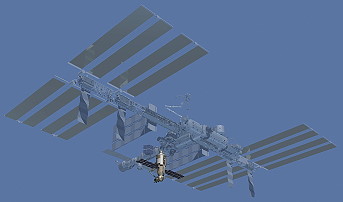 |
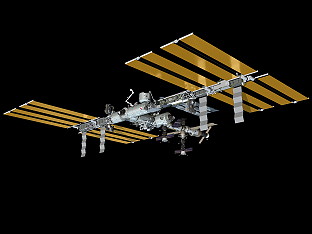 |
 |
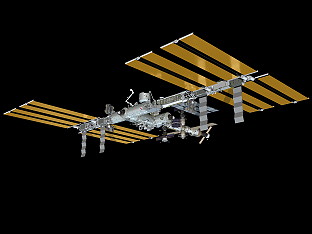 |
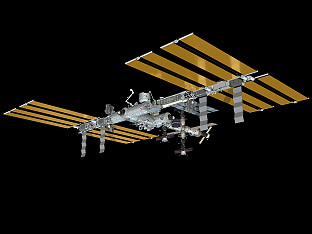 |
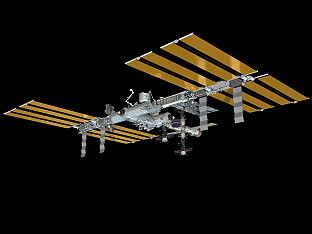 |
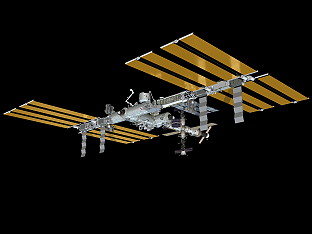 |
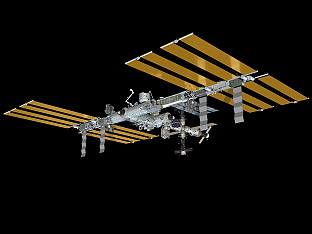 |
|
Photos
 |
 |
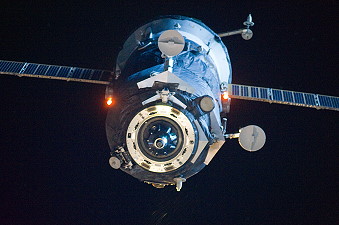 |
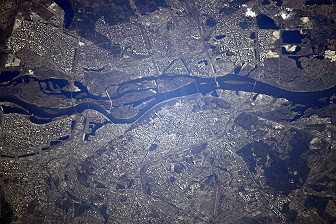 |
 |
 |
 |
 |
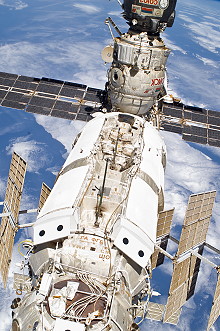 |
|
more Earth observation photos |
|
more onboard photos |
|
| © |  |
Last update on December 14, 2020.  |
 |